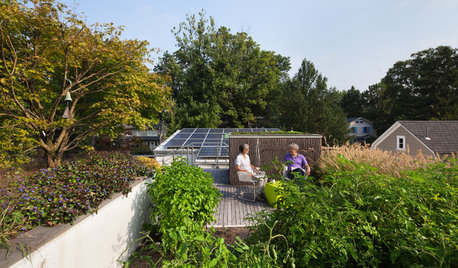Biofarm Locations to be Made Public
althea_gw
19 years ago
Related Stories

HOMES AROUND THE WORLDHouzz Tour: In Japan, a U-Shaped House Made With Natural Materials
Living areas are in one building and private sleeping areas are in another. A kitchen bridges the two structures
Full Story
GREEN BUILDINGHouzz Tour: An Innovative Home Shows What It’s Made Of
Homeowners design their Washington, D.C., residence with sustainability in mind and to accommodate them as they get older
Full Story
TINY HOUSESHouzz Tour: A Custom-Made Tiny House for Skiing and Hiking
Ethan Waldman quit his job, left his large house and spent $42,000 to build a 200-square-foot home that costs him $100 a month to live in
Full Story
ARCHITECTUREIt Takes a Village: 2 Homes Made of Multiple Structures
Separate buildings join in style and intention in these home bases, showing that sometimes more is just right
Full Story
VACATION HOMES5 Homes Made for Après-Ski Indulgence
Strenuous days on the slopes require a warm and pampering retreat to return to, and these homes' amenities hit the spot
Full Story
HOUZZ TOURSMy Houzz: Family and Community Art Merge in an Architect's Home
This Southern California family loved the local artwork so much, they created a public gallery for it right in their house
Full Story
Houzz Tour: A House Built for the Long Term
The designers of this one-of-a-kind home made the most of its challenging location to deliver enduring comfort and style
Full Story
HOUZZ TOURSMy Houzz: A 'Shoe-in' for Creativity in Brooklyn
Can a mini shoe showroom, an office and chic living spaces fit into just 750 square feet? See how one New Yorker made it happen
Full Story
HOUZZ TOURSMy Houzz: Window Love in a Midcentury Texas Home
Ample light sold this couple on their first home, but bold paint colors and DIY projects made it theirs
Full Story
FRANK LLOYD WRIGHTStep Inside a Frank Lloyd Wright House Saved From Demolition
The historic Phoenix property is now part of the architect’s school at Taliesin, where it will be used as a design lab
Full StorySponsored



Millet
althea_gwOriginal Author
Related Discussions
From a local public garden....
Q
public apology
Q
Texas Public Gardens Worth Visiting . . .
Q
Public Broadcast TV Channels
Q
Jason_MI
althea_gwOriginal Author
steve2416
marshallz10
stitches216
Jason_MI
stitches216
marshallz10
Jason_MI
steve2416
Millet
althea_gwOriginal Author
Millet
marshallz10
Millet
marshallz10
stitches216
wayne_5 zone 6a Central Indiana
althea_gwOriginal Author
marshallz10
steve2416
althea_gwOriginal Author
gardengardengardenga
althea_gwOriginal Author
marshallz10
vgkg Z-7 Va
marshallz10
marshallz10
vgkg Z-7 Va
David1
marshallz10
hunter_tx
David1
marshallz10
David1
marshallz10
althea_gwOriginal Author
wayne_5 zone 6a Central Indiana
marshallz10
wayne_5 zone 6a Central Indiana
marshallz10
althea_gwOriginal Author
marshallz10
althea_gwOriginal Author
marshallz10
althea_gwOriginal Author
althea_gwOriginal Author
vgkg Z-7 Va